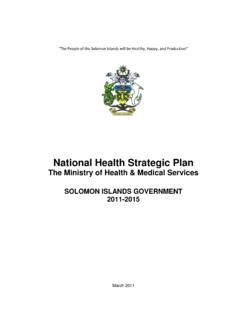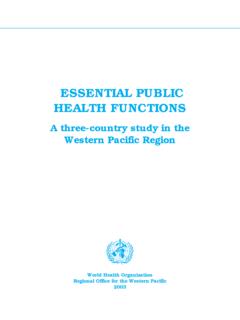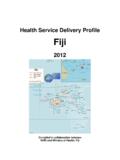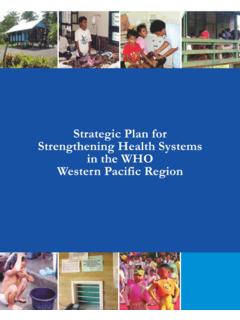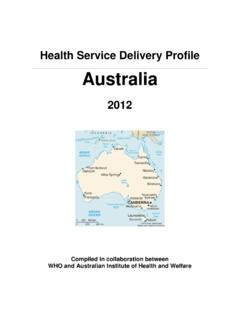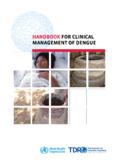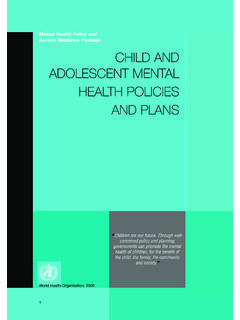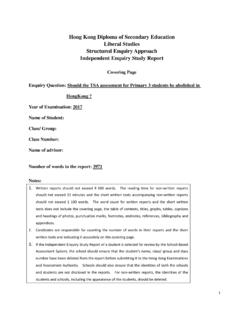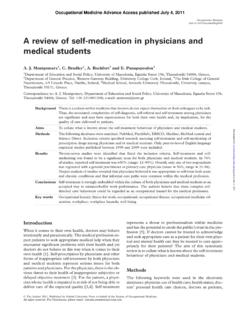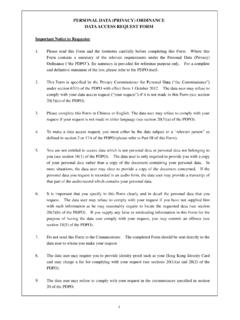Transcription of Social determinants of health - WPRO
1 Introduction health is a universal human aspiration and a basic human need. The development of society, rich orpoor, can be judged by the quality of its population s health , how fairly health is distributed across thesocial spectrum, and the degree of protection provided from disadvantage due to ill- health . Healthequity is central to this premise. Strengthening health equity globally and within countries meansgoing beyond contemporary concentration on the immediate causes of disease to the causes of thecauses the fundamental structures of Social hierarchy and the socially determined conditions thesecreate in which people grow, live, work, and age. The time for action is now, not just because betterhealth makes economic sense, but because it is right and just .Professor Sir Michael Marmot,Interim Statement of the Commission on Social determinants of Health1 Human health is determined not only by contact with the microbes and toxins that directly causeillness or by organ system failures, but also by other biological and Social factors.
2 The terms risks and determinants are often used interchangeably. The intermediate determinants of health include healthservices use, dietary and sanitary practices, and behavioural factors. health inequalities arise fromunequal distribution of underlying determinants , including income and assets, knowledge and influence the intermediate risk factors, for example by constraining health -seeking underlying determinants of health include environment and infrastructure, which create or amelioratedirect risks or limit the ability of the poor to seek health care and practice healthy behaviour. Accessibilityof health services (distance, cost, actual and perceived quality) also determines health determinantsof healthHealth in Asia and the Pacific8 Chapter 2 These determinants are linked with equity in complex ways.
3 Evidence has only recently begun toaccumulate on how public policy can effectively improve the health of the poor. Given the currentstate of knowledge, it is more useful to present the basic data about individual risk factors anddeterminants in the Region than to examine their relationship to health risk factors, including age, sex, genetic profile and health status, are discussed in thechapters on demography, morbidity and mortality. Noncommunicable diseases (NCD), occupationalhealth, nutrition, and environmental hazards are covered in later chapters in greater detail. This chapterdiscusses socioeconomic factors (income and education*) and gender, lifestyle, human rights, foodsecurity and governance : Concern for socioeconomic determinants of health in Viet Nam and ChinaPoor, ethnic minorities and people in remote areas of Viet Nam are the nation s most vulnerablepopulations.
4 health indicators show large disparities by income level. Access to health servicesalso varies with socioeconomic status and residence. The poor who are sick face a high financialburden and use less and lower-cost care. The rise in living standards, including among the poor,is accompanied by increased use of tobacco, alcohol and food consumption. Increased pollution,and poor enforcement of occupational health and safety, and traffic safety standards, posethreats to decentralization of health financing, it is harder for poorer provinces to fund basic healthcare. Rising costs of care are unaffordable for many, but there is political pressure to invest inmore technologically advanced curative services. Poverty reduction and access to health carefor the poor are high priorities for the Government.
5 Policies to reduce health gaps includetargeted subsidies, investments in infrastructure, training at the grassroots level, and preventivehealth programmes focused on maternal and child health and infectious with the traditional health indicators, Social health policy in China now also considerspotential years of life lost, and disability-adjusted life years (DALYs). Important areas of studyinclude health economics, urbanization and health , immunization, tuberculosis control, healthinsurance coverage, maternal health , the life-cycle approach, and gender and shows that a one-year increase in life expectancy is associated with a increase ingross domestic product (GDP), and a 1% increase in health investment is associated with gain in GDP. Gender inequities in health expenditure (benefit incidence) exist in allregions but were highest in eastern China.
6 Women are also disadvantaged in access to care andtimely analysis of equity focuses on health care transition in cities, factors related to healthinsecurity in the regions, and the performance and responsiveness of the Chinese health studies include a surveillance system for behavioural risk factors and the preventionof drug abuse, teenage pregnancies, sexually transmitted infections (STI), and accidents andinjuries. Relationships between health outcomes and population, employment, poverty, educationand Social development are being :Report of the Consultation on Social determinants of health in the Western Pacific Region, 22-24 March2006, Beijing, China. Manila, WHO Regional Office for the Western Pacific, 2006.* Occupation is usually included with socioeconomic status, with exposure to hazards and physical and mental stressobvious determinants of health .
7 This is discussed further in Chapter determinants of Income, poverty and healthSocioeconomic factors determine where people and communities live, the kind of environment theyinhabit, how they are treated by others, the goods and services they can provide for themselves, andwhat their society can provide for them. Countries and areas in the Asia Pacific Region are quiteheterogeneous in terms of their level of socioeconomic development. The grouping of countries andareas in the Region according to this variable is presented in Table of the 48 countries and areas in the Asia Pacific Region accordingto level of development, 2008 Low-incomecountriesBangladeshCambodiaDPR KoreaIndiaLao PDRM ongoliaMyanmarNepalPapua New GuineaSolomon IslandsTimor-LesteViet NamLower middle-income countriesBhutanChinaFijiIndonesiaKiribat iMaldivesMarshall IslandsMicronesia,Federated States ofPhilippinesSamoaSri LankaThailandTongaVanuatuUpper middle-income countriesAmerican SamoaMalaysiaNorthern MarianaIslandsPalauHigh-incomecountriesA ustraliaBrunei DarussalamFrench PolynesiaGuamHong Kong (China)JapanMacao (China)
8 New CaledoniaNew ZealandRepublic of KoreaSingaporeClassificationnot knownCook IslandsNauruNiuePitcairn IslandsTokelauTuvaluWallis and FutunaPoverty, both as a Social concept and as a measurable characteristic, relates to many of thesesocioeconomic factors. Poorer countries or areas often cannot provide adequate preventive and curativehealth services, and poor individuals and households cannot move from unhealthy surroundings, buyenough food or use the services that exist. Poor communities usually do not have the political powerneeded to get better many less developed and low-income countries in the Region, health status is relatively low interms of life expectancy and other indicators. Yet people in some poor countries have good healthbecause they have focused resources on improving the Social determinants of health education andadult literacy, water and sanitation, health promotion and food health is a result of many factors other than costly health care, although people living in mostwealthy countries do enjoy long life expectancy.
9 Infant mortality is a better indicator of health systemeffectiveness than life expectancy and generally decreases with increased income and health and human development indicators for 29 countries in the Region from the United NationsDevelopment Programme (UNDP)2 and WHO3 databases are shown in Table These highlight thelarge differences in the Region, and indicate relationships between poverty and Human Development Index (HDI) is an average of three indices of (1) a long and healthy life,as measured by life expectancy at birth; (2) knowledge, as measured by adult literacy and schoolenrolment; and (3) living standard, as measured by adjusted per capita income. The most developedcountries in the Region have HDIs nearly double the least developed (Figure ); however, manycountries are improving rapidly and narrowing the :World development report 2008: agriculture for development.
10 Washington DC, The International Bankfor Reconstruction and Development / The World in Asia and the Pacific10 Chapter 2 Fig. in Human Development Index (HDI) in five Asia Pacific Region countriesSource:Human development reports. New York, United Nations Development of KoreaJapanReal income per capita (adjusted for purchasing power) ranges from nearly US$ 30 000 in Australiaand Japan to well under US$ 2000 in five countries, a ratio of about 15:1. Most of the Region spopulation live in large countries having real GDPs per capita under US$ 5000. High average incomedoes not always translate into Social well-being because wealth may be concentrated in the hands ofa few. The Gini Index reflects inequality of income distribution, with values ranging from forJapan, which is indicative of the lowest level of inequality, to values nearly twice as high for severalpoor countries such as Papua New Guinea (Table ).
